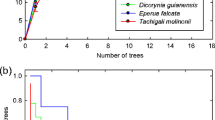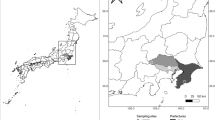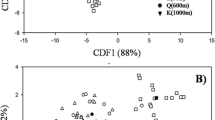Abstract
Understanding the dynamics of arbuscular mycorrhizal fungi (AMF) in response to land use change is important for the restoration of degraded forests. Here, we investigated the AMF community composition in the roots of Pterocarpus tinctorius sampled from agricultural and forest fallow soils rich in aluminum and iron. By sequencing the large subunit region of the rRNA gene, we identified a total of 30 operational taxonomic units (OTUs) in 33 root samples. These OTUs belonged to the genera Rhizophagus, Dominikia, Glomus, Sclerocystis, and Scutellospora. The majority of these OTUs did not closely match any known AMF species. We found that AMF species richness was significantly influenced by soil properties and overall tree density. Acidic soils with high levels of aluminum and iron had a low mean AMF species richness of 3.2. Indicator species analyses revealed several AMF OTUs associated with base saturation (4 OTUs), high aluminum (3 OTUs), and iron (2 OTUs). OTUs positively correlated with acidity (1 OTU), iron, and available phosphorus (2 OTUs) were assigned to the genus Rhizophagus, suggesting their tolerance to aluminum and iron. The results highlight the potential of leguminous trees in tropical dry forests as a reservoir of unknown AMF species. The baseline data obtained in this study opens new avenues for future studies, including the use of indigenous AMF-based biofertilizers to implement ecological revegetation strategies and improve land use.



Similar content being viewed by others
Availability of data and materials
The original contributions presented in the study are included in the article/supplementary material. Further inquiries can be directed to the corresponding author.
References
Altschul SF, Gish W, Miller W et al (1990) Basic local alignment search tool. J Mol Biol 215:403–410. https://doi.org/10.1016/s0022-2836(05)80360-2
Asmelash F, Bekele T, Birhane E (2016) The potential role of arbuscular mycorrhizal fungi in the restoration of degraded lands. Front Microbiol 7:1095. https://doi.org/10.3389/fmicb.2016.01095
Bâ A, Dalpé Y, Guissou T (1996) Les glomales d’Acacia holosericea et d’Acacia mangium. Bois & Forêts des tropiques 250:5–18. https://doi.org/10.19182/bft1996.250.a19862
Bates D, Mächler M, Bolker B, Walker S (2015) Fitting linear mixed-effects models using lme4. J Stat Softw 67. https://doi.org/10.18637/jss.v067.i01
Belay Z, Vestberg M, Assefa F (2013) Diversity and abundance of arbuscular mycorrhizal fungi associated with acacia trees from different land use systems in Ethiopia. Afr J Microbiol Res 7:5503–5515. https://doi.org/10.5897/ajmr2013.6115
Bento RA, Saggin-Júnior OJ, Pitard RM et al (2012) Selection of leguminous trees associated with symbiont microorganisms for phytoremediation of petroleum-contaminated soil. Water Air Soil Pollut 223:5659–5671. https://doi.org/10.1007/s11270-012-1305-3
Błaszkowski J, Chwat G, Góralska A et al (2015) Two new genera, Dominikia and Kamienskia, and D. disticha sp. nov. in Glomeromycota. Nova Hedwigia 100:225–238. https://doi.org/10.1127/nova_hedwigia/2014/0216
Bouyoucos GJ (1962) Hydrometer method improved for making particle size analyses of soils1. Agron J 54:464–465. https://doi.org/10.2134/agronj1962.00021962005400050028x
Bray RH, Kurtz LT (1945) Determination of total, organic, and available forms of phosphorus in soils. Soil Sci 59:39–46. https://doi.org/10.1097/00010694-194501000-00006
Brundrett MC, Tedersoo L (2018) Evolutionary history of mycorrhizal symbioses and global host plant diversity. New Phytol 220:1108–1115. https://doi.org/10.1111/nph.14976
Castro D, Urzúa J, Rodriguez-Malebran M et al (2017) Woody leguminous trees: new uses for sustainable development of drylands. J Sustain Forest 36:764–786. https://doi.org/10.1080/10549811.2017.1359098
Cerutti PO, Gumbo DJ, Moombe KB et al (2018) Mukula (rosewood) trade between China and Zambia. CIFOR Infobrief 215. https://doi.org/10.17528/cifor/006880
Chen H (2018) VennDiagram: generate high-resolution Venn and Euler plots. Version R package version 1.6.20. https://CRAN.R-project.org/package=VennDiagram
Corporation C (2016) General guidelines to assist with microwave digestion method development
Crossay T, Cilia A, Cavaloc Y et al (2018) Four new species of arbuscular mycorrhizal fungi (Glomeromycota) associated with endemic plants from ultramafic soils of New Caledonia. Mycol Prog 17:729–744. https://doi.org/10.1007/s11557-018-1386-5
Dalpé Y, Diop TA, Plenchette C, Gueye M (2000) Glomales species associated with surface and deep rhizosphere of Faidherbia albida in Senegal. Mycorrhiza 10:125–129. https://doi.org/10.1007/s005720000069
Dormann CF, Gruber B, Fruend J (2008) Introducing the bipartite package: analyzing ecological networks. R News 8:8–11
Echevarria G (2017) Agromining: farming for metals, extracting unconventional resources using plants. Mineral Resour Rev 135–156. https://doi.org/10.1007/978-3-319-61899-9_8
FAO (2006) World reference base for soil resources 2006. World soil resources reports No. 103. Food and Agriculture Organization of the United Nations, Rome
Gaidashova S, Nsabimana A, Karamura D et al (2012) Mycorrhizal colonization of major banana genotypes in six East African environments. Agric Ecosyst Environ 157:40–46. https://doi.org/10.1016/j.agee.2012.01.005
Geoffroy A, Sanguin H, Galiana A, Bâ A (2017) Molecular characterization of arbuscular mycorrhizal fungi in an agroforestry system reveals the predominance of Funneliformis spp. associated with Colocasia esculenta and Pterocarpus officinalis adult trees and seedlings. Front Microbiol 8:1426. https://doi.org/10.3389/fmicb.2017.01426
Gianinazzi S, Gollotte A, Binet M-N et al (2010) Agroecology: the key role of arbuscular mycorrhizas in ecosystem services. Mycorrhiza 20:519–530. https://doi.org/10.1007/s00572-010-0333-3
Gollotte A, van Tuinen D, Atkinson D (2003) Diversity of arbuscular mycorrhizal fungi colonizing roots of the grass species Agrostis capillaris and Lolium perenne in a field experiment. Mycorrhiza 14:111–117. https://doi.org/10.1007/s00572-003-0244-7
Hall TA (1999) BioEdit: a user-friendly biological sequence alignment editor and analysis program for Windows 95/98/NT. Nucleic Acids Symp Ser 41:95–98
Harrell FE (2018) Hmisc: Harrell miscellaneous. Version R package version 4.1–1. https://hbiostat.org/R/Hmisc/
Hart MM, Reader RJ (2002) Taxonomic basis for variation in the colonization strategy of arbuscular mycorrhizal fungi. New Phytol 153:335–344. https://doi.org/10.1046/j.0028-646x.2001.00312.x
Hogberg P, Piearce GD (1986) Mycorrhizas in Zambian trees in relation to host taxonomy, vegetation type and successional patterns. J Ecol 74:775. https://doi.org/10.2307/2260397
Holste EK, Holl KD, Zahawi RA, Kobe RK (2016) Reduced aboveground tree growth associated with higher arbuscular mycorrhizal fungal diversity in tropical forest restoration. Ecol Evol 6:7253–7262. https://doi.org/10.1002/ece3.2487
Hothorn T, Bretz F, Westfall P (2008) Simultaneous inference in general parametric models. Biometrical J 50:346–363. https://doi.org/10.1002/bimj.200810425
Janos DP, Sahley CT, Emmons LH (1995) Rodent dispersal of vesicular-arbuscular mycorrhizal fungi in Amazonian Peru. Ecology 76:1852–1858. https://doi.org/10.2307/1940717
Katoh K, Standley DM (2013) MAFFT multiple sequence alignment software version 7: improvements in performance and usability. Mol Biol Evol 30:772–780. https://doi.org/10.1093/molbev/mst010
Khade SW, Rodrigues BF (2003) Occurrence of arbuscular mycorrhizal fungi in tree species from Western Ghats of Goa. India J Trop for Sci 15(2):320–331
Kiruki HM, van der Zanden EH, Gikuma-Njuru P, Verburg PH (2017) The effect of charcoal production and other land uses on diversity, structure and regeneration of woodlands in a semi-arid area in Kenya. Forest Ecol Manag 391:282–295. https://doi.org/10.1016/j.foreco.2017.02.030
Krüger M, Krüger C, Walker C et al (2012) Phylogenetic reference data for systematics and phylotaxonomy of arbuscular mycorrhizal fungi from phylum to species level. New Phytol 193:970–984. https://doi.org/10.1111/j.1469-8137.2011.03962.x
Lebrazi S, Fikri-Benbrahim K (2022) Advances in legumes for sustainable intensification. 461–482. https://doi.org/10.1016/b978-0-323-85797-0.00004-5
Lekberg Y, Gibbons SM, Rosendahl S, Ramsey PW (2013) Severe plant invasions can increase mycorrhizal fungal abundance and diversity. ISME J 7:1424–1433. https://doi.org/10.1038/ismej.2013.41
Luginbuehl LH, Menard GN, Kurup S et al (2017) Fatty acids in arbuscular mycorrhizal fungi are synthesized by the host plant. Sci New York N Y 356:1175–1178. https://doi.org/10.1126/science.aan0081
Malaisse F (1997) Se nourrir en forêt claire africaine. Les Presses Agronomiques de Gembloux, Approche écologique et nutritionnelle
Manaut N, Sanguin H, Ouahmane L et al (2015) Potentialities of ecological engineering strategy based on native arbuscular mycorrhizal community for improving afforestation programs with carob trees in degraded environments. Ecol Eng 79:113–119. https://doi.org/10.1016/j.ecoleng.2015.03.007
Martínez-García LB, Richardson SJ, Tylianakis JM et al (2015) Host identity is a dominant driver of mycorrhizal fungal community composition during ecosystem development. New Phytol 205:1565–1576. https://doi.org/10.1111/nph.13226
Mathimaran N, Ruh R, Jama B et al (2007) Impact of agricultural management on arbuscular mycorrhizal fungal communities in Kenyan ferralsol. Agric Ecosyst Environ 119:22–32. https://doi.org/10.1016/j.agee.2006.06.004
Mensah JA, Koch AM, Antunes PM et al (2015) High functional diversity within species of arbuscular mycorrhizal fungi is associated with differences in phosphate and nitrogen uptake and fungal phosphate metabolism. Mycorrhiza 25:533–546. https://doi.org/10.1007/s00572-015-0631-x
Mgumia FH (2017) Traditional uses of miombo woodland tree species in Sikonge District, Tanzania. Int J Nat Resour Ecol Management 2:69. https://doi.org/10.11648/j.ijnrem.20170204.11
Moora M, Davison J, Öpik M et al (2014) Anthropogenic land use shapes the composition and phylogenetic structure of soil arbuscular mycorrhizal fungal communities. FEMS Microbiol Ecol 90:609–621. https://doi.org/10.1111/1574-6941.12420
Mukenza MM, Muteya HK, Nghonda D-DN et al (2022) Uncontrolled exploitation of Pterocarpus tinctorius Welw. and associated landscape dynamics in the Kasenga territory: case of the rural area of Kasomeno (DR Congo). Land 11:1541. https://doi.org/10.3390/land11091541
Ngongo M, Ranst EV, Baert G et al (2009) Guide des sols en République Démocratique du Congo, tome I: étude et gestion. Ecole Technique Salama-Don Bosco
Oehl F, Laczko E, Bogenrieder A et al (2010) Soil type and land use intensity determine the composition of arbuscular mycorrhizal fungal communities. Soil Biol Biochem 42:724–738. https://doi.org/10.1016/j.soilbio.2010.01.006
Oksanen J, Blanchet FG, Friendly M et al (2019) vegan: community ecology package. R package version 2.5–6. Version 2.5–6. https://CRAN.R-project.org/package=vegan
Öpik M, Vanatoa A, Vanatoa E et al (2010) The online database MaarjAM reveals global and ecosystemic distribution patterns in arbuscular mycorrhizal fungi (Glomeromycota). New Phytol 188:223–241. https://doi.org/10.1111/j.1469-8137.2010.03334.x
Ouellette M-H (2011) MVPARTwrap: additional functionalities for package mvpart. Version 0.1–9. https://cran.r-project.org/src/contrib/Archive/MVPARTwrap/
Peel MC, Finlayson BL, McMahon TA (2007) Updated world map of the Köppen-Geiger climate classification. Hydrol Earth Syst Sc 11:1633–1644. https://doi.org/10.5194/hess-11-1633-2007
Procter AC, Ellis JC, Fay PA et al (2014) Fungal community responses to past and future atmospheric CO2 differ by soil type. Appl Environ Microb 80:7364–7377. https://doi.org/10.1128/aem.02083-14
R Core Team (2018) R: A language and environment for statistical computing. R Foundation for Statistical Computing, Vienna. https://www.R-project.org.L
Rich MK, Vigneron N, Libourel C et al (2021) Lipid exchanges drove the evolution of mutualism during plant terrestrialization. Science 372:864–868. https://doi.org/10.1126/science.abg0929
Roberts DW (2019) labdsv: ordination and multivariate analysis for ecology. Version 2.0–1
Rodríguez-Echeverría S, Teixeira H, Correia M et al (2017) Arbuscular mycorrhizal fungi communities from tropical Africa reveal strong ecological structure. New Phytol 213:380–390. https://doi.org/10.1111/nph.14122
Sene G, Samba-Mbaye R, Thiao M et al (2012a) The abundance and diversity of legume-nodulating rhizobia and arbuscular mycorrhizal fungal communities in soil samples from deforested and man-made forest systems in a semiarid Sahel region in Senegal. Eur J Soil Biol 52:30–40. https://doi.org/10.1016/j.ejsobi.2012.05.005
Sene G, Thiao M, Manga A et al (2012b) Arbuscular mycorrhizal soil infectivity and spores distribution across plantations of tropical, subtropical and exotic tree species: a case study from the forest reserve of Bandia, Senegal. Afr J Ecol 50:218–232. https://doi.org/10.1111/j.1365-2028.2011.01315.x
Sene G, Thiao M, Samba-Mbaye R et al (2013) The abundance and diversity of legume-nodulating rhizobia in 28-year-old plantations of tropical, subtropical, and exotic tree species: a case study from the forest reserve of Bandia, Senegal. Microbial Ecol 65:128–144. https://doi.org/10.1007/s00248-012-0094-y
Spruyt A, Buck MT, Mia A, Straker CJ (2014) Arbuscular mycorrhiza (AM) status of rehabilitation plants of mine wastes in South Africa and determination of AM fungal diversity by analysis of the small subunit rRNA gene sequences. S Afr J Bot 94:231–237. https://doi.org/10.1016/j.sajb.2014.07.006
Stefani F, Bencherif K, Sabourin S et al (2020a) Taxonomic assignment of arbuscular mycorrhizal fungi in an 18S metagenomic dataset: a case study with saltcedar (Tamarix aphylla). Mycorrhiza. https://doi.org/10.1007/s00572-020-00946-y
Straker CJ, Hilditch AJ, Rey MEC (2010) Arbuscular mycorrhizal fungi associated with cassava (Manihot esculenta Crantz) in South Africa. S Afr J Bot 76:102–111. https://doi.org/10.1016/j.sajb.2009.09.005
Syampungani S, Geldenhuys CJ, Chirwa PW (2016) Regeneration dynamics of Miombo woodland in response to different anthropogenic disturbances: forest characterisation for sustainable management. Agroforest Syst 90:563–576. https://doi.org/10.1007/s10457-015-9841-7
Tapwal A, Kumar R, Pandey S (2013) Diversity and frequency of macrofungi associated with wet ever green tropical forest in Assam, India. Biodiversitas 14(2):73–78. https://doi.org/10.13057/biodiv/d140204
Timberlake J, Sawadogo ECL, Sawadogo L (2010) Distribution and characteristics of African dry forests and woodlands. In: The dry forests and woodlands of Africa
van der Heijden MGA, Bardgett RD, van Straalen NM (2008) The unseen majority: soil microbes as drivers of plant diversity and productivity in terrestrial ecosystems. Ecol Lett 11:296–310. https://doi.org/10.1111/j.1461-0248.2007.01139.x
Van Tuinen D, Zhao B, Gianinazzi-Pearson V (1998) Mycorrhiza manual. In: Varma A (ed). Springer-Verlag, Berlin Heidelberg New York, pp 387–400
Wang J, Wang GG, Zhang B et al (2019) Arbuscular mycorrhizal fungi associated with tree species in a planted forest of Eastern China. Forests 10:424. https://doi.org/10.3390/f10050424
Wei T, Simko V (2017) R package “corrplot”: visualization of a correlation matrix. Version 0.84. https://github.com/taiyun/corrplot
Yonli HH, Sene G, Sanon KB, Dianda M, Khasa DP (2022) Senegalia senegal (L.) Britton response to microbial and manure amendments for the rehabilitation of waste rock dumps in the Essakane gold mining site, Burkina Faso. Front Environ Sci 10:803009. https://doi.org/10.3389/fenvs.2022.803009
Zeileis A, Hothorn T (2002) Diagnostic checking in regression relationships. R News 2(3):7–10
Acknowledgements
The authors would like to thank the forest engineers Eric Lowele and Christian Kanunda for their assistance during the floristic inventory, sample collection, and preparation. We thank Stéphane Daigle, research professional in the Centre d’Étude de la Forêt (CEF) for his help with the statistical analyses. Additionally, we thank Marie-Ève Beaulieu for her help with the molecular and bioinformatics analyses. An NSERC Discovery Grant (DPK) is acknowledged. W.F.J. Parsons corrected the English.
Funding
This study was funded by a doctoral fellowship from the Réseau des Institutions de Formation Forestière et Environnementale d’Afrique Centrale (RIFFEAC), through its project to support the Expanded Program of Training in Natural Resource Management in the Congo Basin (PEFOGRN-BC) funded by the Congo Basin Forest Fund, managed by the African Development Bank. This work also received an NSERC Discovery Grant (DPK).
Author information
Authors and Affiliations
Contributions
JMKK and DKP conceived and designed the experiments. JMKK performed all the experiments and analyses. JMKK and GS wrote the first draft of the manuscript. FS co-supervised JMKK and rewrote the subsequent version of the manuscripts with GS. DKP was responsible for supervision and project management, as well as funding and resource acquisition. All authors provided critical input to the drafts and gave final approval for publication.
Corresponding author
Ethics declarations
Competing interests
The authors declare no competing interests.
Additional information
Publisher's Note
Springer Nature remains neutral with regard to jurisdictional claims in published maps and institutional affiliations.
Supplementary Information
Below is the link to the electronic supplementary material.
Rights and permissions
Springer Nature or its licensor (e.g. a society or other partner) holds exclusive rights to this article under a publishing agreement with the author(s) or other rightsholder(s); author self-archiving of the accepted manuscript version of this article is solely governed by the terms of such publishing agreement and applicable law.
About this article
Cite this article
Kaumbu, JM.K., Sene, G., Stefani, F. et al. Characterization of the arbuscular mycorrhizal fungal community associated with rosewood in threatened Miombo forests. Mycorrhiza 33, 277–288 (2023). https://doi.org/10.1007/s00572-023-01115-7
Received:
Accepted:
Published:
Issue Date:
DOI: https://doi.org/10.1007/s00572-023-01115-7




